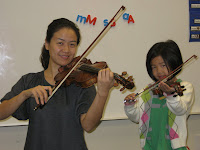
Today (day 18 of our project) was a big day for our Fast Plants. The children took bee-sticks (dried honey bees glued onto a skewer) and gently moved it (the bee-stick) from flower to flower carrying the tiny pollen which will help our flowers complete their life cycle. After they swirled the bee around for a while, they looked at it under the digital microscope. They were excited to see all of the yellow flecks clinging to the bees body. New vocabulary introduced with this activity: pollen, pollinate, pollination. The children now understand how important bees are to plants and to animals.



